Case Analysis: Burger King vs. Hoot - Federal Trademark Law Review
VerifiedAdded on 2023/05/29
|7
|1552
|422
Case Study
AI Summary
This case analysis examines the legal dispute between Burger King and Hoot, focusing on trademark law, federal registration, and intellectual property rights. The analysis details the court's decision, emphasizing the superiority of federal trademark registration over state registration and its impact on the geographical operation of the businesses. It also explores the significance of the Lanham Act in governing trademark infringement and dilution. Furthermore, the document discusses threats to intellectual property in the modern world, including hacking and insider theft, and outlines protections like trademarks, copyrights, and patents. The analysis concludes with a discussion on how mineral rights can impact business decisions, particularly concerning land ownership and resource extraction. The provided references support the arguments presented throughout the case analysis.
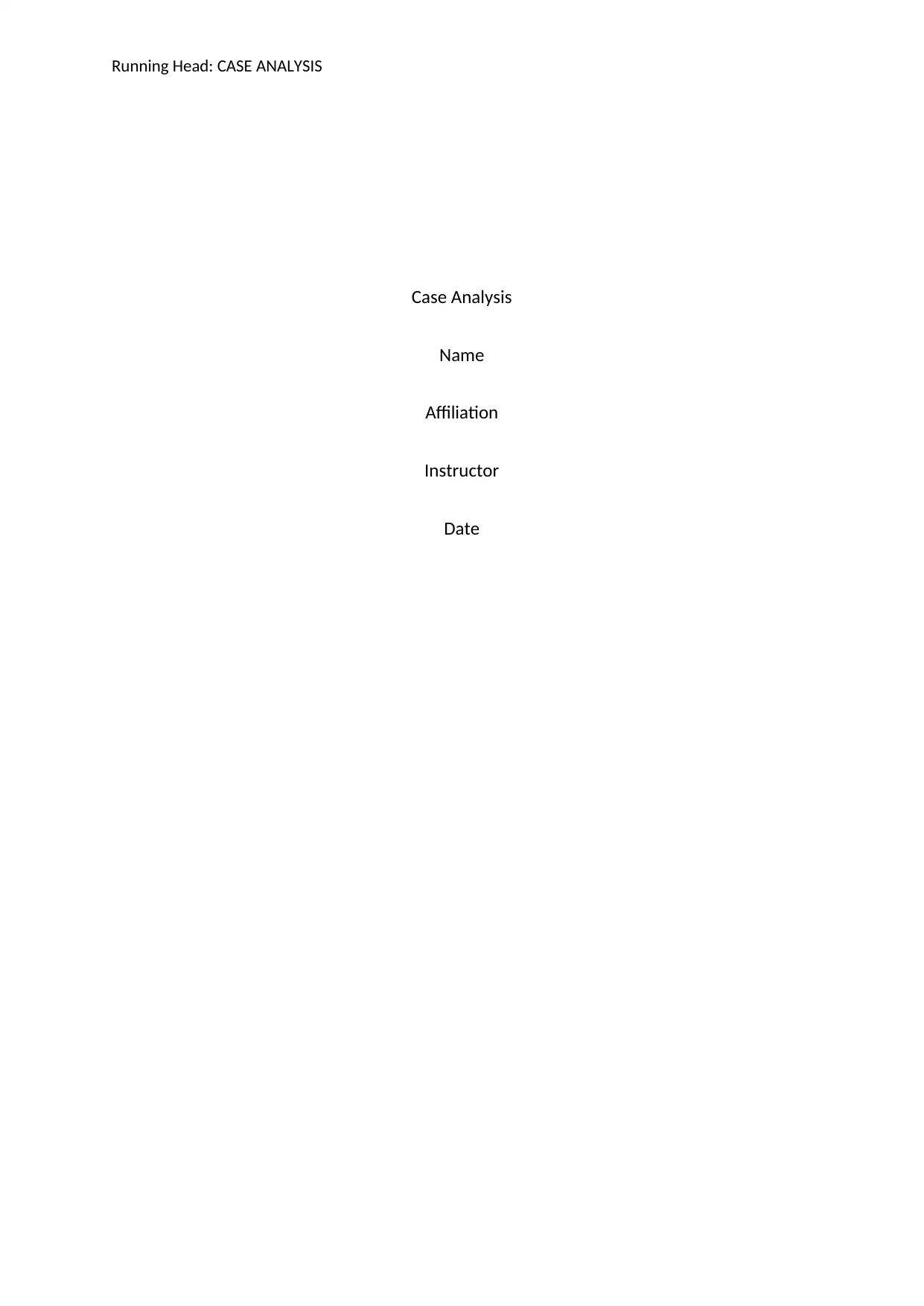
Running Head: CASE ANALYSIS
Case Analysis
Name
Affiliation
Instructor
Date
Case Analysis
Name
Affiliation
Instructor
Date
Paraphrase This Document
Need a fresh take? Get an instant paraphrase of this document with our AI Paraphraser
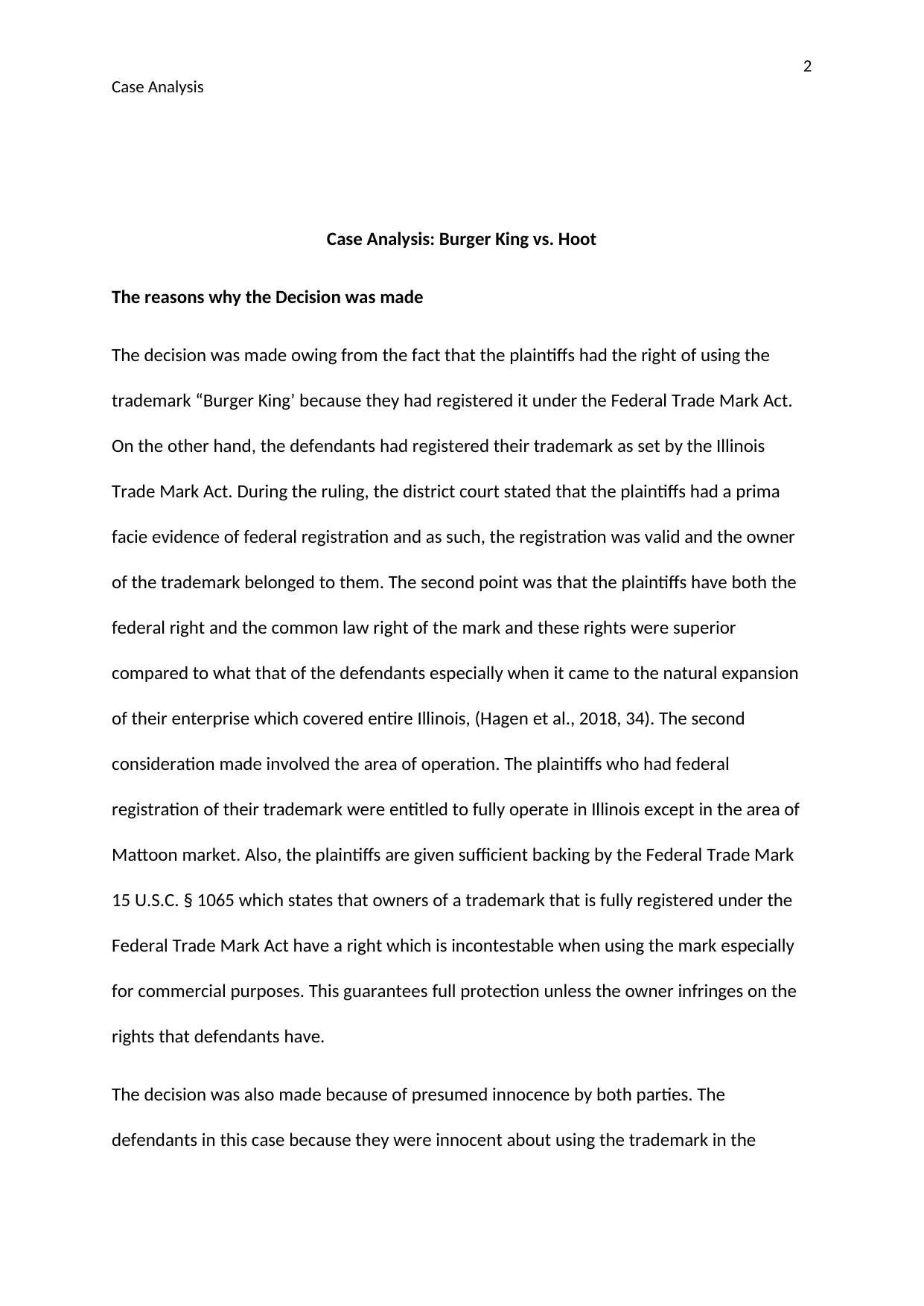
2
Case Analysis
Case Analysis: Burger King vs. Hoot
The reasons why the Decision was made
The decision was made owing from the fact that the plaintiffs had the right of using the
trademark “Burger King’ because they had registered it under the Federal Trade Mark Act.
On the other hand, the defendants had registered their trademark as set by the Illinois
Trade Mark Act. During the ruling, the district court stated that the plaintiffs had a prima
facie evidence of federal registration and as such, the registration was valid and the owner
of the trademark belonged to them. The second point was that the plaintiffs have both the
federal right and the common law right of the mark and these rights were superior
compared to what that of the defendants especially when it came to the natural expansion
of their enterprise which covered entire Illinois, (Hagen et al., 2018, 34). The second
consideration made involved the area of operation. The plaintiffs who had federal
registration of their trademark were entitled to fully operate in Illinois except in the area of
Mattoon market. Also, the plaintiffs are given sufficient backing by the Federal Trade Mark
15 U.S.C. § 1065 which states that owners of a trademark that is fully registered under the
Federal Trade Mark Act have a right which is incontestable when using the mark especially
for commercial purposes. This guarantees full protection unless the owner infringes on the
rights that defendants have.
The decision was also made because of presumed innocence by both parties. The
defendants in this case because they were innocent about using the trademark in the
Case Analysis
Case Analysis: Burger King vs. Hoot
The reasons why the Decision was made
The decision was made owing from the fact that the plaintiffs had the right of using the
trademark “Burger King’ because they had registered it under the Federal Trade Mark Act.
On the other hand, the defendants had registered their trademark as set by the Illinois
Trade Mark Act. During the ruling, the district court stated that the plaintiffs had a prima
facie evidence of federal registration and as such, the registration was valid and the owner
of the trademark belonged to them. The second point was that the plaintiffs have both the
federal right and the common law right of the mark and these rights were superior
compared to what that of the defendants especially when it came to the natural expansion
of their enterprise which covered entire Illinois, (Hagen et al., 2018, 34). The second
consideration made involved the area of operation. The plaintiffs who had federal
registration of their trademark were entitled to fully operate in Illinois except in the area of
Mattoon market. Also, the plaintiffs are given sufficient backing by the Federal Trade Mark
15 U.S.C. § 1065 which states that owners of a trademark that is fully registered under the
Federal Trade Mark Act have a right which is incontestable when using the mark especially
for commercial purposes. This guarantees full protection unless the owner infringes on the
rights that defendants have.
The decision was also made because of presumed innocence by both parties. The
defendants in this case because they were innocent about using the trademark in the
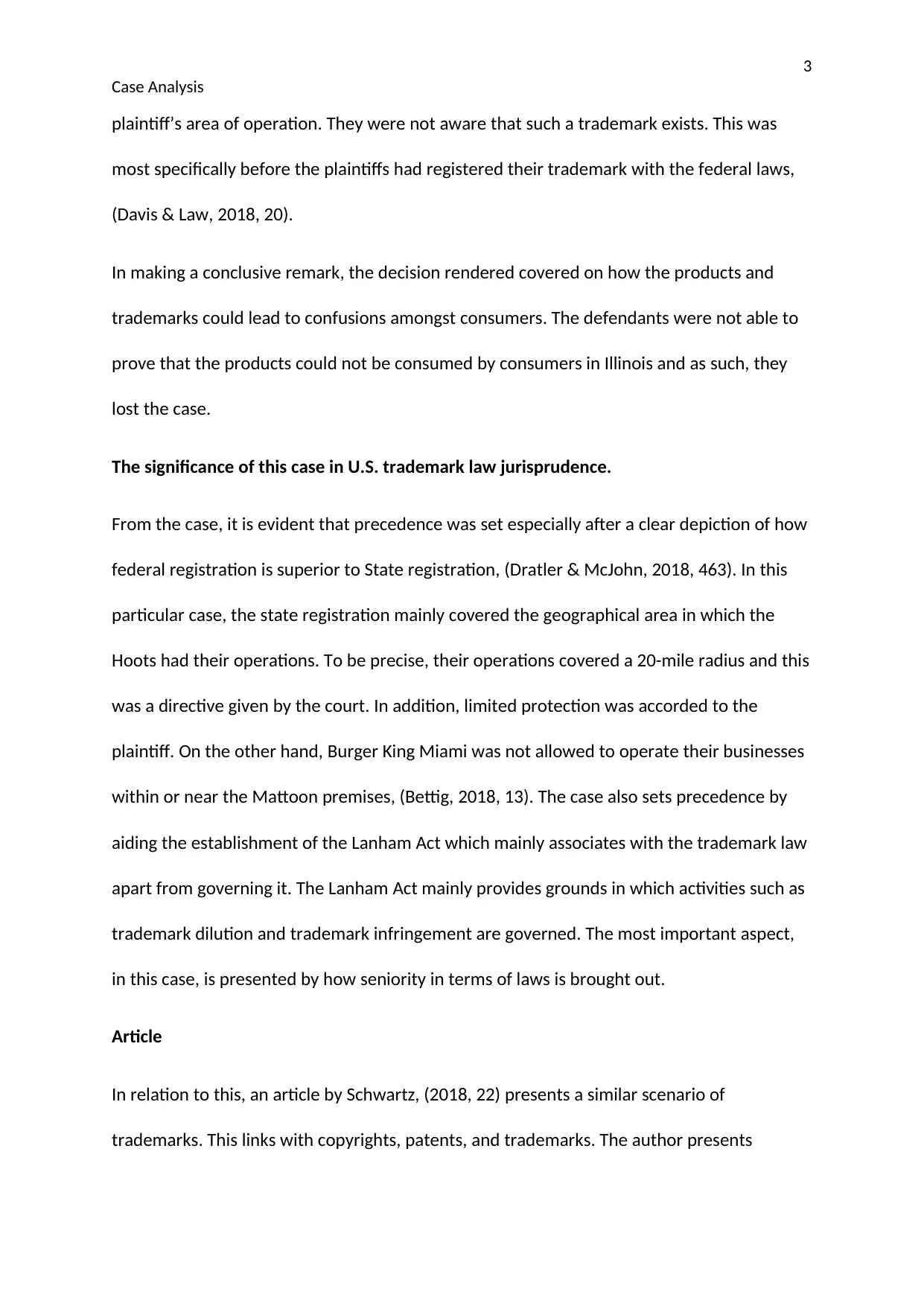
3
Case Analysis
plaintiff’s area of operation. They were not aware that such a trademark exists. This was
most specifically before the plaintiffs had registered their trademark with the federal laws,
(Davis & Law, 2018, 20).
In making a conclusive remark, the decision rendered covered on how the products and
trademarks could lead to confusions amongst consumers. The defendants were not able to
prove that the products could not be consumed by consumers in Illinois and as such, they
lost the case.
The significance of this case in U.S. trademark law jurisprudence.
From the case, it is evident that precedence was set especially after a clear depiction of how
federal registration is superior to State registration, (Dratler & McJohn, 2018, 463). In this
particular case, the state registration mainly covered the geographical area in which the
Hoots had their operations. To be precise, their operations covered a 20-mile radius and this
was a directive given by the court. In addition, limited protection was accorded to the
plaintiff. On the other hand, Burger King Miami was not allowed to operate their businesses
within or near the Mattoon premises, (Bettig, 2018, 13). The case also sets precedence by
aiding the establishment of the Lanham Act which mainly associates with the trademark law
apart from governing it. The Lanham Act mainly provides grounds in which activities such as
trademark dilution and trademark infringement are governed. The most important aspect,
in this case, is presented by how seniority in terms of laws is brought out.
Article
In relation to this, an article by Schwartz, (2018, 22) presents a similar scenario of
trademarks. This links with copyrights, patents, and trademarks. The author presents
Case Analysis
plaintiff’s area of operation. They were not aware that such a trademark exists. This was
most specifically before the plaintiffs had registered their trademark with the federal laws,
(Davis & Law, 2018, 20).
In making a conclusive remark, the decision rendered covered on how the products and
trademarks could lead to confusions amongst consumers. The defendants were not able to
prove that the products could not be consumed by consumers in Illinois and as such, they
lost the case.
The significance of this case in U.S. trademark law jurisprudence.
From the case, it is evident that precedence was set especially after a clear depiction of how
federal registration is superior to State registration, (Dratler & McJohn, 2018, 463). In this
particular case, the state registration mainly covered the geographical area in which the
Hoots had their operations. To be precise, their operations covered a 20-mile radius and this
was a directive given by the court. In addition, limited protection was accorded to the
plaintiff. On the other hand, Burger King Miami was not allowed to operate their businesses
within or near the Mattoon premises, (Bettig, 2018, 13). The case also sets precedence by
aiding the establishment of the Lanham Act which mainly associates with the trademark law
apart from governing it. The Lanham Act mainly provides grounds in which activities such as
trademark dilution and trademark infringement are governed. The most important aspect,
in this case, is presented by how seniority in terms of laws is brought out.
Article
In relation to this, an article by Schwartz, (2018, 22) presents a similar scenario of
trademarks. This links with copyrights, patents, and trademarks. The author presents
⊘ This is a preview!⊘
Do you want full access?
Subscribe today to unlock all pages.

Trusted by 1+ million students worldwide
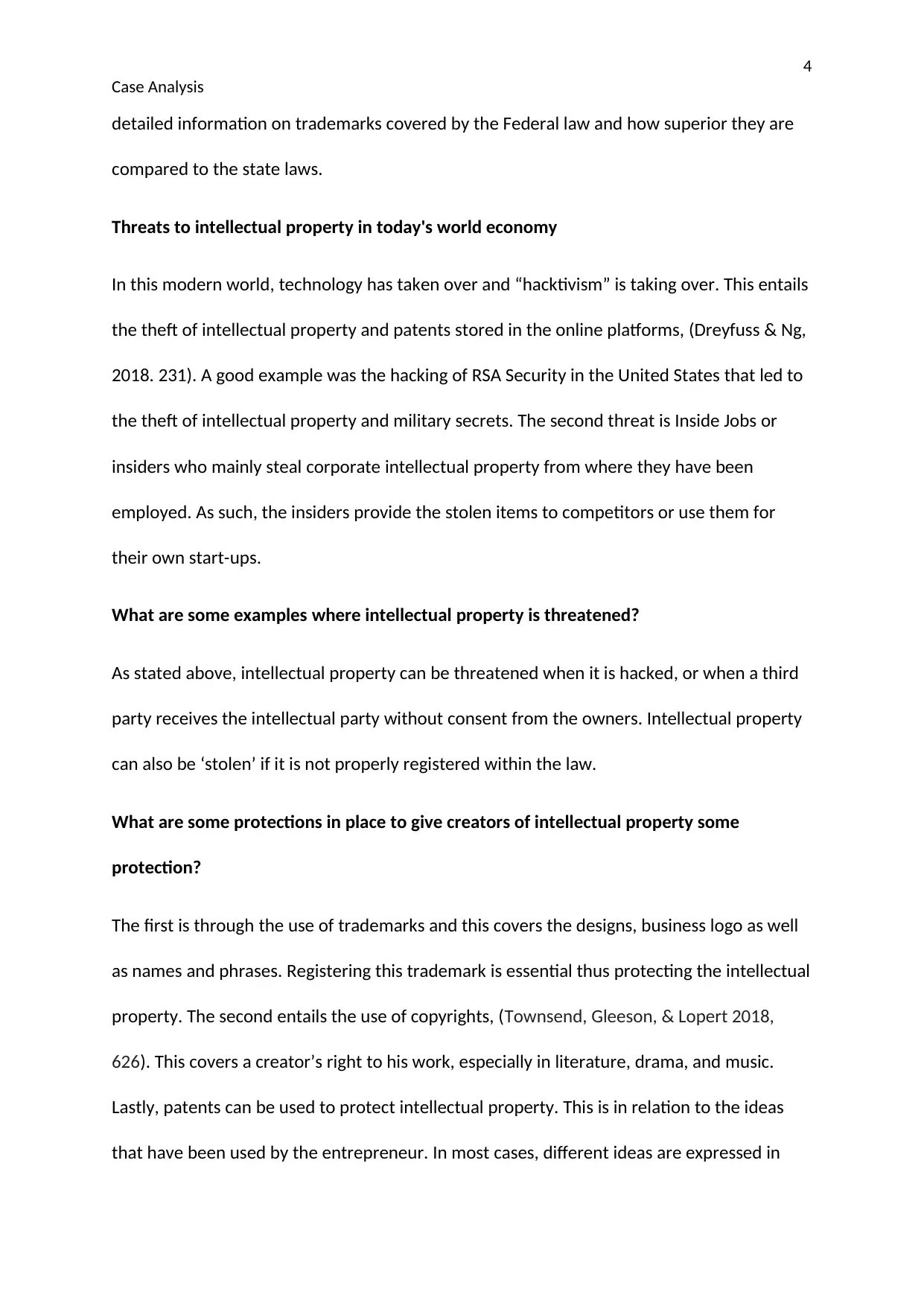
4
Case Analysis
detailed information on trademarks covered by the Federal law and how superior they are
compared to the state laws.
Threats to intellectual property in today's world economy
In this modern world, technology has taken over and “hacktivism” is taking over. This entails
the theft of intellectual property and patents stored in the online platforms, (Dreyfuss & Ng,
2018. 231). A good example was the hacking of RSA Security in the United States that led to
the theft of intellectual property and military secrets. The second threat is Inside Jobs or
insiders who mainly steal corporate intellectual property from where they have been
employed. As such, the insiders provide the stolen items to competitors or use them for
their own start-ups.
What are some examples where intellectual property is threatened?
As stated above, intellectual property can be threatened when it is hacked, or when a third
party receives the intellectual party without consent from the owners. Intellectual property
can also be ‘stolen’ if it is not properly registered within the law.
What are some protections in place to give creators of intellectual property some
protection?
The first is through the use of trademarks and this covers the designs, business logo as well
as names and phrases. Registering this trademark is essential thus protecting the intellectual
property. The second entails the use of copyrights, (Townsend, Gleeson, & Lopert 2018,
626). This covers a creator’s right to his work, especially in literature, drama, and music.
Lastly, patents can be used to protect intellectual property. This is in relation to the ideas
that have been used by the entrepreneur. In most cases, different ideas are expressed in
Case Analysis
detailed information on trademarks covered by the Federal law and how superior they are
compared to the state laws.
Threats to intellectual property in today's world economy
In this modern world, technology has taken over and “hacktivism” is taking over. This entails
the theft of intellectual property and patents stored in the online platforms, (Dreyfuss & Ng,
2018. 231). A good example was the hacking of RSA Security in the United States that led to
the theft of intellectual property and military secrets. The second threat is Inside Jobs or
insiders who mainly steal corporate intellectual property from where they have been
employed. As such, the insiders provide the stolen items to competitors or use them for
their own start-ups.
What are some examples where intellectual property is threatened?
As stated above, intellectual property can be threatened when it is hacked, or when a third
party receives the intellectual party without consent from the owners. Intellectual property
can also be ‘stolen’ if it is not properly registered within the law.
What are some protections in place to give creators of intellectual property some
protection?
The first is through the use of trademarks and this covers the designs, business logo as well
as names and phrases. Registering this trademark is essential thus protecting the intellectual
property. The second entails the use of copyrights, (Townsend, Gleeson, & Lopert 2018,
626). This covers a creator’s right to his work, especially in literature, drama, and music.
Lastly, patents can be used to protect intellectual property. This is in relation to the ideas
that have been used by the entrepreneur. In most cases, different ideas are expressed in
Paraphrase This Document
Need a fresh take? Get an instant paraphrase of this document with our AI Paraphraser
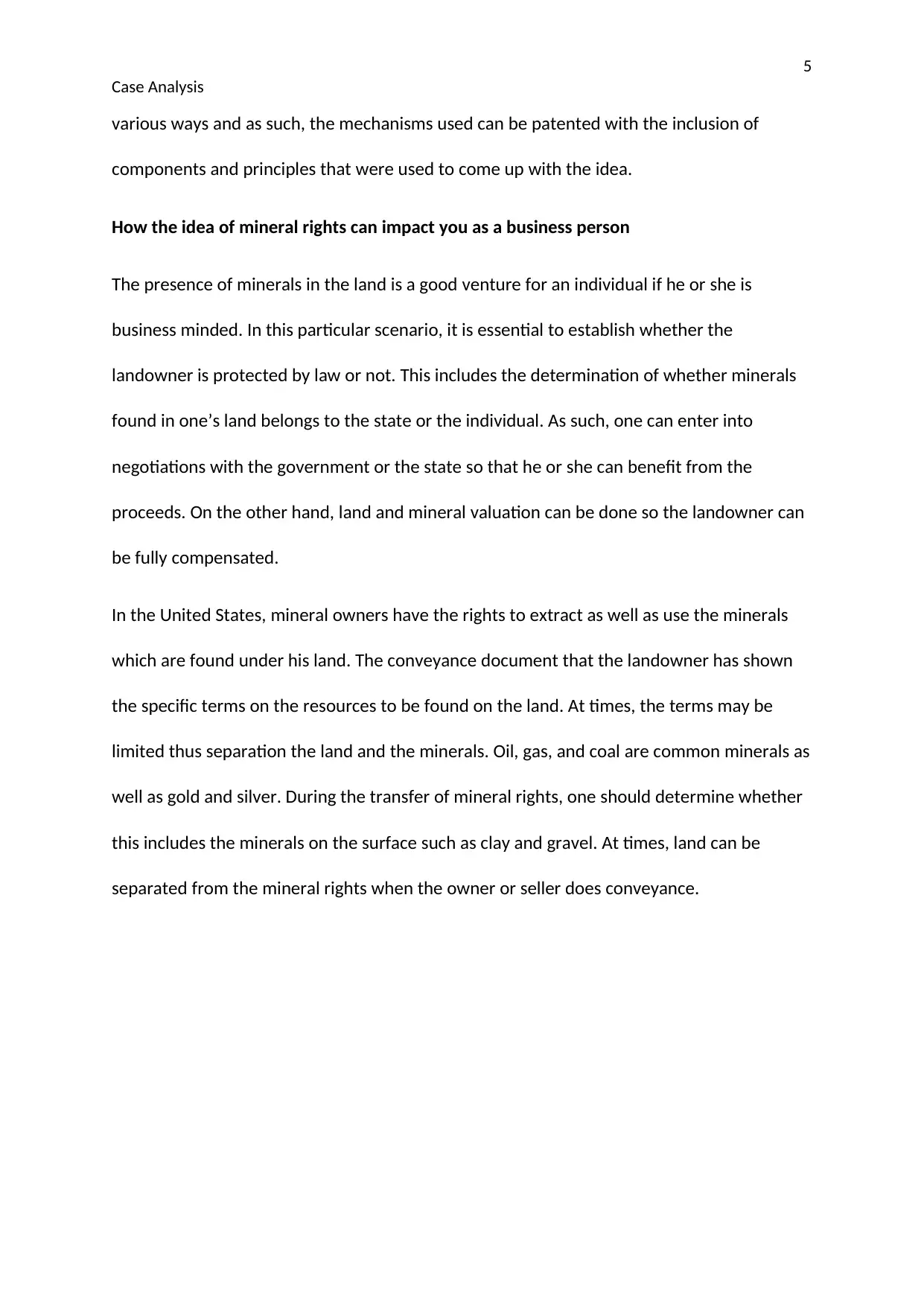
5
Case Analysis
various ways and as such, the mechanisms used can be patented with the inclusion of
components and principles that were used to come up with the idea.
How the idea of mineral rights can impact you as a business person
The presence of minerals in the land is a good venture for an individual if he or she is
business minded. In this particular scenario, it is essential to establish whether the
landowner is protected by law or not. This includes the determination of whether minerals
found in one’s land belongs to the state or the individual. As such, one can enter into
negotiations with the government or the state so that he or she can benefit from the
proceeds. On the other hand, land and mineral valuation can be done so the landowner can
be fully compensated.
In the United States, mineral owners have the rights to extract as well as use the minerals
which are found under his land. The conveyance document that the landowner has shown
the specific terms on the resources to be found on the land. At times, the terms may be
limited thus separation the land and the minerals. Oil, gas, and coal are common minerals as
well as gold and silver. During the transfer of mineral rights, one should determine whether
this includes the minerals on the surface such as clay and gravel. At times, land can be
separated from the mineral rights when the owner or seller does conveyance.
Case Analysis
various ways and as such, the mechanisms used can be patented with the inclusion of
components and principles that were used to come up with the idea.
How the idea of mineral rights can impact you as a business person
The presence of minerals in the land is a good venture for an individual if he or she is
business minded. In this particular scenario, it is essential to establish whether the
landowner is protected by law or not. This includes the determination of whether minerals
found in one’s land belongs to the state or the individual. As such, one can enter into
negotiations with the government or the state so that he or she can benefit from the
proceeds. On the other hand, land and mineral valuation can be done so the landowner can
be fully compensated.
In the United States, mineral owners have the rights to extract as well as use the minerals
which are found under his land. The conveyance document that the landowner has shown
the specific terms on the resources to be found on the land. At times, the terms may be
limited thus separation the land and the minerals. Oil, gas, and coal are common minerals as
well as gold and silver. During the transfer of mineral rights, one should determine whether
this includes the minerals on the surface such as clay and gravel. At times, land can be
separated from the mineral rights when the owner or seller does conveyance.
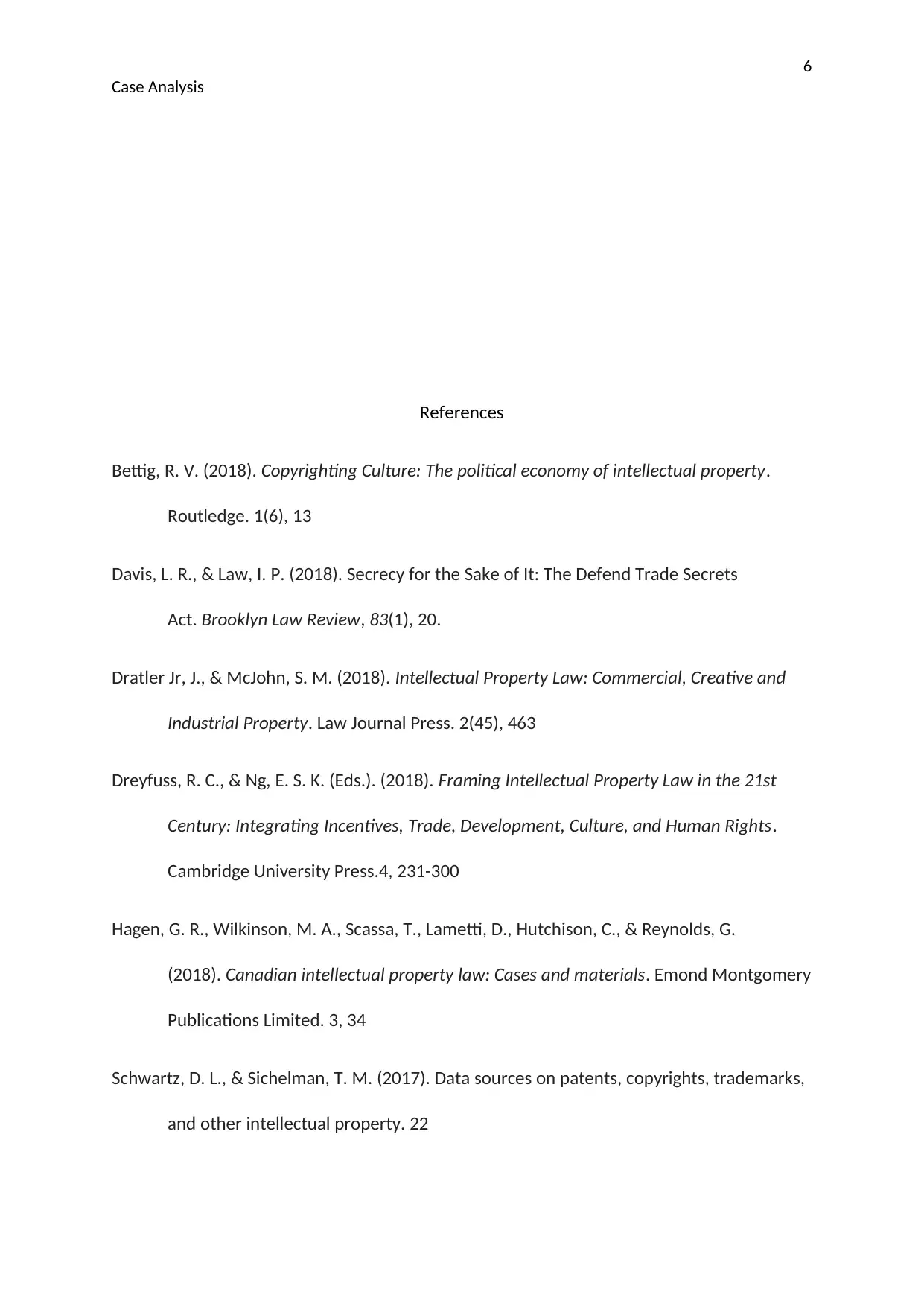
6
Case Analysis
References
Bettig, R. V. (2018). Copyrighting Culture: The political economy of intellectual property.
Routledge. 1(6), 13
Davis, L. R., & Law, I. P. (2018). Secrecy for the Sake of It: The Defend Trade Secrets
Act. Brooklyn Law Review, 83(1), 20.
Dratler Jr, J., & McJohn, S. M. (2018). Intellectual Property Law: Commercial, Creative and
Industrial Property. Law Journal Press. 2(45), 463
Dreyfuss, R. C., & Ng, E. S. K. (Eds.). (2018). Framing Intellectual Property Law in the 21st
Century: Integrating Incentives, Trade, Development, Culture, and Human Rights.
Cambridge University Press.4, 231-300
Hagen, G. R., Wilkinson, M. A., Scassa, T., Lametti, D., Hutchison, C., & Reynolds, G.
(2018). Canadian intellectual property law: Cases and materials. Emond Montgomery
Publications Limited. 3, 34
Schwartz, D. L., & Sichelman, T. M. (2017). Data sources on patents, copyrights, trademarks,
and other intellectual property. 22
Case Analysis
References
Bettig, R. V. (2018). Copyrighting Culture: The political economy of intellectual property.
Routledge. 1(6), 13
Davis, L. R., & Law, I. P. (2018). Secrecy for the Sake of It: The Defend Trade Secrets
Act. Brooklyn Law Review, 83(1), 20.
Dratler Jr, J., & McJohn, S. M. (2018). Intellectual Property Law: Commercial, Creative and
Industrial Property. Law Journal Press. 2(45), 463
Dreyfuss, R. C., & Ng, E. S. K. (Eds.). (2018). Framing Intellectual Property Law in the 21st
Century: Integrating Incentives, Trade, Development, Culture, and Human Rights.
Cambridge University Press.4, 231-300
Hagen, G. R., Wilkinson, M. A., Scassa, T., Lametti, D., Hutchison, C., & Reynolds, G.
(2018). Canadian intellectual property law: Cases and materials. Emond Montgomery
Publications Limited. 3, 34
Schwartz, D. L., & Sichelman, T. M. (2017). Data sources on patents, copyrights, trademarks,
and other intellectual property. 22
⊘ This is a preview!⊘
Do you want full access?
Subscribe today to unlock all pages.

Trusted by 1+ million students worldwide
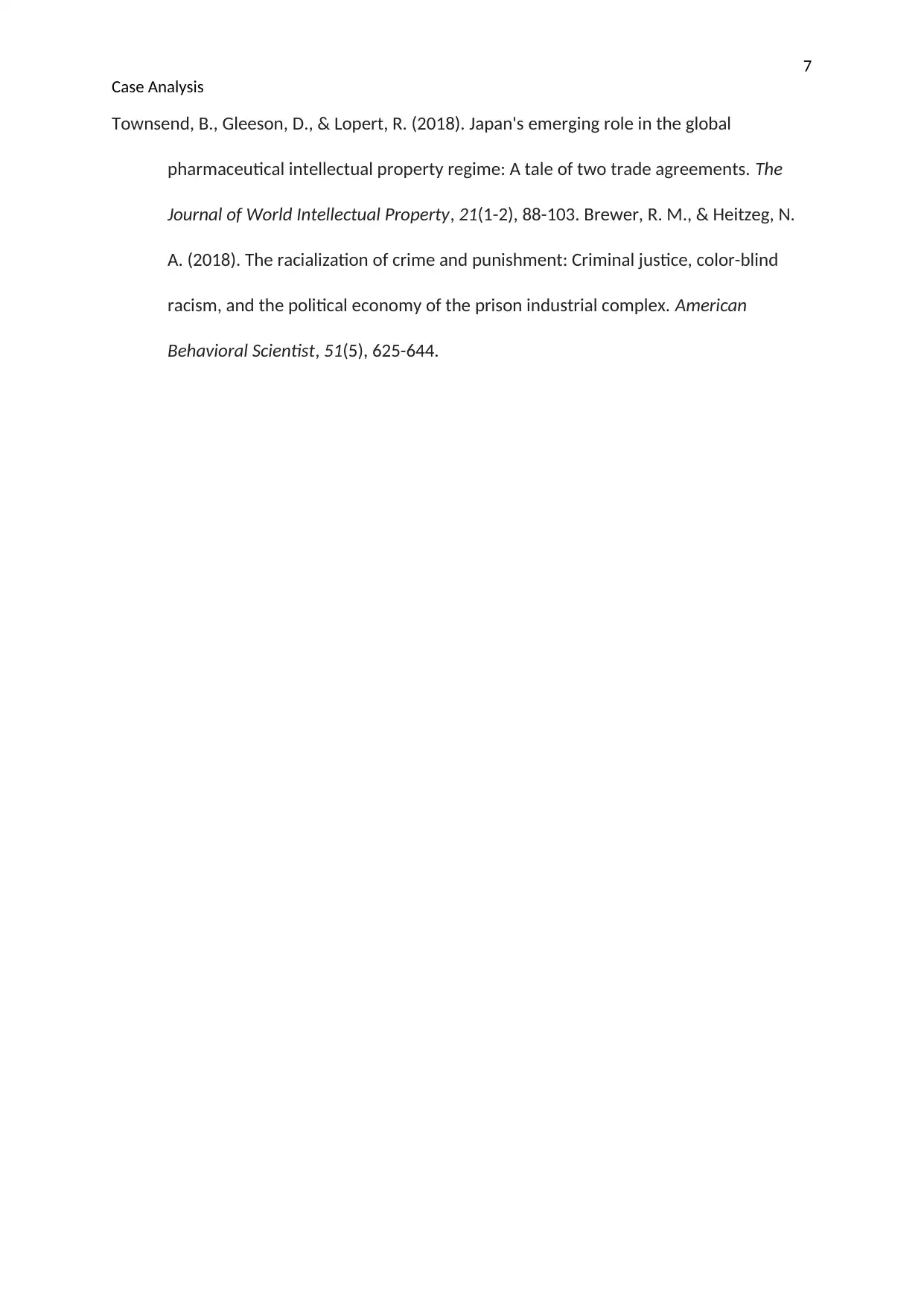
7
Case Analysis
Townsend, B., Gleeson, D., & Lopert, R. (2018). Japan's emerging role in the global
pharmaceutical intellectual property regime: A tale of two trade agreements. The
Journal of World Intellectual Property, 21(1-2), 88-103. Brewer, R. M., & Heitzeg, N.
A. (2018). The racialization of crime and punishment: Criminal justice, color-blind
racism, and the political economy of the prison industrial complex. American
Behavioral Scientist, 51(5), 625-644.
Case Analysis
Townsend, B., Gleeson, D., & Lopert, R. (2018). Japan's emerging role in the global
pharmaceutical intellectual property regime: A tale of two trade agreements. The
Journal of World Intellectual Property, 21(1-2), 88-103. Brewer, R. M., & Heitzeg, N.
A. (2018). The racialization of crime and punishment: Criminal justice, color-blind
racism, and the political economy of the prison industrial complex. American
Behavioral Scientist, 51(5), 625-644.
1 out of 7
Related Documents
Your All-in-One AI-Powered Toolkit for Academic Success.
+13062052269
info@desklib.com
Available 24*7 on WhatsApp / Email
![[object Object]](/_next/static/media/star-bottom.7253800d.svg)
Unlock your academic potential
Copyright © 2020–2025 A2Z Services. All Rights Reserved. Developed and managed by ZUCOL.





